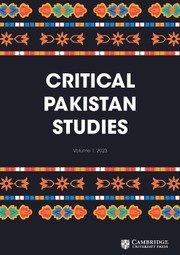Faiza Moatasim’s powerfully argued and astutely observed Master Plans and Encroachments makes the compelling case that thinking about a city such as Islamabad in terms of “master plan” and “encroachment” is, in fact, profoundly misleading. False dichotomies lend themselves far too easily to making sense of new capital cities in the “Global South.” Such dichotomies respond to the ideological purpose of these new urban spaces as radically ‘different’ and as emblems of national “development”. They tap into foundational binaries between “modernity” and its many “others” underpinning modernization theory and postcolonial criticism alike. The resulting stories have become almost too familiar: architect superheroes such as Le Corbusier, Niemeyer, or Doxiadis seek to impose their controlling gaze on the exuberant messiness of life in a poor and “backward” world.Footnote 1 (Neo-)colonial forms of knowledge are imposed from above and meet indigenous “resistance.” Regulation-obsessed state bureaucrats and baton wielding police platoons confront the poorest and most marginalized inhabitants of urban space, who then often emerge sanctified as heroic representations of a liberational subject position.
Moatasim remains mindful of injustice and inequality, but her work gently demolishes binary divisions of this kind. As far as its actual role in everyday urban administration goes, C.A. Doxiadis’s visionary Islamabad master plan appears less as a “high modernist” machine of disciplinary power and more like first among equals, with many overlapping regulatory frameworks creatively stretched, adapted, or even ignored in never-ending negotiations over rights to urban space. Justice Shaukat Aziz Siddiqui’s 2014 order to maintain Islamabad’s purity as a “state-of-the-art city,” through the ruthless enforcement of zoning legislation and clearing of encroachments, was very much exceptional and came from a politically motivated member of the judiciary rather than the city authorities themselves. While the availability of wealth and political connections certainly plays a major role in the tactics chosen by different groups of residents, Moatasim highlights the similarities in how rich and poor seek to secure their advantage in an expansive grey area between legality and illegality. They all speculate, encroach, use deception and architectural camouflage, seek out regulatory loopholes, manipulate the power of courts, and (on rare occasion) resort to collective action. The “state” in Moatasim’s account is neither a simple enforcer of regulations nor a unitary institution. The Capital Development Authority (CDA) fights its own battles with Union Councils and the courts, showing infinite inventiveness in the creation of semi-legal or temporary “rights” and obligations. A nudge and a wink are as much part of its standard administrative repertoire as a fine or eviction notice.
The book presents four thematic case studies exploring how spatial politics work in practice: informal property and tenancy rights in France Colony, a mostly Christian and low-caste irregular settlement right at the heart of one of Islamabad poshest sectors; temporary encroachments by both ordinary and elite businesses across the city; the illegal (or rather semi-legal) land grabbing around Bani Gala in Islamabad’s designated national park and recreation area; and finally, the use of residential properties for commercial use in contradiction to zoning legislation.
Moatasim’s perspective is that of a trained architect venturing out for anthropological field work, archival study, and oral history. Her professional training allows her to focus on elements in the workings of the everyday state that social scientists or historians would likely miss. Claims to space are communicated and recognized through documents and the use of certain building materials and architectural designs. In what she calls “long-term temporariness,” the owners of khokas and shops may deliberately choose reusable materials to mark their venues as make-shift, which ironically then allows them to be tolerated by the CDA as “temporary” over very long periods of time, establishing a sense of semi-permanency. In this manner, the authority can safeguard the sanctity of the master plan in principle while also creating the flexibility a city like Islamabad needs to function. In a similar vein, architectural design has been used to negotiate infringements on zoning legislation. Doxiadis’s plan was based on the strict separation of residential and commercial areas, which forced many enterprises – from doctors and beauticians to private schools, boutiques, furniture shops, hotels, restaurants, and even embassies – to operate out of large residential buildings in due course. In terms of design, the needs of the enterprise in question had to be balanced against the need to preserve a residential architectural appearance, again not so much to deceive the planning authorities but rather to enable them to turn a blind eye without overstepping their own standards. Architecture was, in fact, a negotiation that could be continued into the legal domain through the imposition and payment of fines, or through the long-term pursuit of cases through the courts that helped freeze the status quo into another form of “long-term temporariness.”
What remains after reading Master Plans and Encroachments is a sense of everyday politics in Pakistan as an infinitely flexible and inventive game shared across social divisions, which – despite the very real presence of brutality and inequality – amounts to a complicated but workable way of organizing life in a rapidly changing urban environment. To restore a sense of “normality” to Islamabad – where ordinary people simply do their best to come to terms with a challenging, but not hopeless, environment – involves trade-offs, however. Moatasim’s analysis gains its sharpness from a tight empirical observation of one place in what could be described as a temporality of the everyday. To the historian, at least, it is disorienting to read an analysis of politics that completely glosses over changes in governments and regimes. It is strange to see events in the 1970s placed alongside events in the 1990s and 2000s as if changing circumstances did not matter. Episodes such as Justice Siddiqui’s aforementioned enforcement drive appear as incomprehensible bolts out of the blue to this optic. Equally revealingly, the book finds space for a (largely rhetorical) comparison with Los Angeles but no space for anything connecting Islamabad to Karachi, Lahore, or the rest of Pakistan for that matter.


